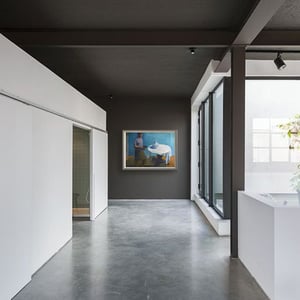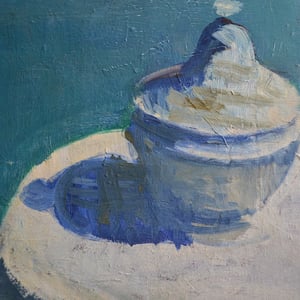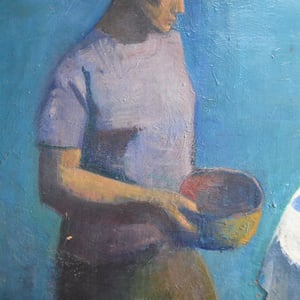Large, 1964 Painting, 'White Table Cloth,' Jean Langlois (1923-2014)
£1,775.00 Sold out

Large, 1964 Painting, 'White Table Cloth,' Jean Langlois (1923-2014)
In this huge painting Langlois presents a portrait of a woman in profile nursing a wooden bowl. On the table in front of her, bathed in white light, a solitary soupier stands with dancing ultramarine shadows. A vast 'sky' of cyan creates a vibrant backdrop and a Caramac ground contrasts beautifully. Matisse-like in execution this is a stunning painting full of colour and mystery.
About the Artist
Jean Langlois
Born in the city of Nancy, in Lorraine, on March 8, 1923, Jean Langlois was the son of army officer, whereas his mother was a former alumnus of the prestigious School of Decorative Arts in Paris. After serving his country in the muddy trenches of Verdun like so many of his fellow countrymen, Langlois, Sr. became a pioneer of French aviation in the wake of the Great War, at a time when flying airplanes provided an experience akin to horseback riding. In his middle age, Jean’s father would eventually turn into a noted documentary filmmaker.
Jean belongs to the generation of First World War baby boomers hailed by the celebrated French poet and singer George Brassens. He spent the first seven years of his life on the Arvor Air Base, near the city of Bourges in central France, before his family moved back to Nancy. By his mid-teens, Jean lived in Paris where his father was stationed. As the Second World War broke out in 1939, Jean dropped out of high school in order to pursue his passion for sketching at the Paris School of Applied Arts. This first experience was short-lived as squadron-leader Langlois was sent to Algiers in the wake of the capitulation, and Jean spent the next two years at the local School of Fine Arts, honing his skills and exploring the works of the Old Masters. The paintings of El Greco provided him with the initial shock that shaped his future as an artist.
Back on French soil with his family in 1941, Jean enrolled in the decorative painting program at the School of Applied Arts where he discovered his next “mentor,” Tintoretto, as well as Goya, Daumier, Michel-Angelo, Matisse, the Impressionists and French painting in general.
The Paris School of Applied Arts at the time was placed under the tutelage of Fressinet, famous for his knack at hiring renowned teachers (sculptor Wlérik is one example). Jean Langlois also received the teachings of Jacques Zwoboda, shortly before the latter founded his own Grande Chaumière academy where Jean became his massier, in charge of recruiting models and training students.
Jean, then aged 19, took part in the Liberation of Paris, in August 1944, before joining the allied forces, fighting his way into Nazi Germany until the end of the war.
Back in Paris, Langlois tutored art students at the Superior School of Modern Arts where he was a mainstay between 1947 and 1991, a period of over four decades dedicated to the art of drawing and devoted to fundamental research in aesthetics, for the greater benefit of several generations of pupils whose faithfulness and dedication later contributed to the furthering of his career.
Jean Langlois has long been gracefully inept at beating his own artistic drum, and owes several close friends, most of them alumni (Jacques Landron, Jean-Marie Zachi…), the honor of seeing his work exhibited.
Georges Grandet played a major role in the spreading of his name, spending much time and effort in the day to day operation of the art gallery, located on rue du Cardinal Lemoine, where Jean’s work was exhibited continuously between 1982 and 1992. In this convenient location, near the Tour d’Argent in the 5th arrondissement, Langlois met with a large number of admirers, from France and abroad, who have often visited since his studio near the city of Sens.
Stubbornly allergic to self-satisfaction and self-promotion, proudly protective of his deep sense of independence, adamantly critical of a world led by the tyranny of the media and the despotism of concepts, Jean has always refused to provoke for the sake of provocation, to show off in the name of eccentricity. Light years away from the stereotypical pose of the artist, he asserts his inalienable right to dress and talk like an ordinary man while making art his everyday business.
In more than sixty years, Jean Langlois has managed to build an impressive body of work, away from the attention of the specialized media and art institutions. Six decades spent in the solitude of his studio, brush in hand, polishing details and refining impressions in search of perfection in the reproduction of his fictionalized vision of reality.
Jean’s painting is decidedly figurative, in keeping with the canons of classical painting, light years from intellectual movements, trends and fashions. Without rejecting abstract art with which he shares an interest for shapes, colors and spatial dynamics, he considers that the figurative school has the edge due to its dedication to the subject.
Although Jean will concede that the subject is often a pretext for the elaboration of shapes and the arrangement of colors, he argues that it is an invaluable ingredient well worth fighting for. Favoring technical skills over conceptualization, Langlois has never been a strong supporter of contemporary art. He feels the energy of the artist should be devoted exclusively to his paintings, considering with reason that figurative art offers a transcendent vision of reality, as a glance at Monet’s works will prove.
A devotee of Asian etchings, African sculptures and Hindu frescoes, Jean Langlois is heir to a tradition that goes back to prehistoric times and cave painting, when fledgling creators naively invented figurative art by silhouetting deer and buffalos on rocky walls.
Jean’s realm is his studio. Surrounded by his favorite objects, he feels free to imagine combinations of shapes, create color arrangements. A Japanese armor, a wooden horse, a piece of fabric lazily wrapped around the back of a chair, an African mask, an old crock or the landscape surging from his window can give birth to an exciting composition. No object, no subject is too trite for the artist who will transcend it into a new reality.
Although his favorite piece is The Immigrants—a small 10” painting by Daumier—, Jean finds he expresses himself better on 8 to 10 feet canvasses.
Jean Langlois co-founded the Talma Group in 1965 with Jacques Landron and Jean Marnat. His work has been exhibited on numerous occasions in shows, museums and galleries, including the Musée du Mans, Salon d’Automne, Salon des Artistes Français, Salon des Indépendants, Salon Comparaisons, Salon Terre Latine, the Marcel Bernheim gallery, the Katia Granoff Gallery, and the Galerie Cardinal of his late friend Georges Grandet, where his paintings where shown continuously from 1982 to 1992. More recently, a retrospective of his career took place at the Chaumont abbey in 2008. Langlois was nominated for the Prix de la Critique in 1967, and awarded the Médaille d’or des Artistes Français in 1968.
Jean Langlois left us on January 15, 2014. Three months before his death, when he was 90 years old, he was still busy painting during a few hours, everyday in his studio. In the nursing home where he spent his last days he was always asking the same question: « What I’m I doing here? I’ve got work to do at the studio! »
New Frame, ready to hang
Size:
Frame: Width X Height
CM: 144 x 104
Inches: 57 x 41
Painting:
CM: 130 x 97
Inches: 51 x 38
Medium: Oil on canvas
Provenance: Jean Langlois Studio Sale, Paris 2019 Signed lower left
Date; Circa 1964
Condition; Excellent
Shipping by arrangement




